Citroen BERLINGO RHD 2017 2.G Owner's Manual
Manufacturer: CITROEN, Model Year: 2017, Model line: BERLINGO RHD, Model: Citroen BERLINGO RHD 2017 2.GPages: 260, PDF Size: 8.59 MB
Page 141 of 260
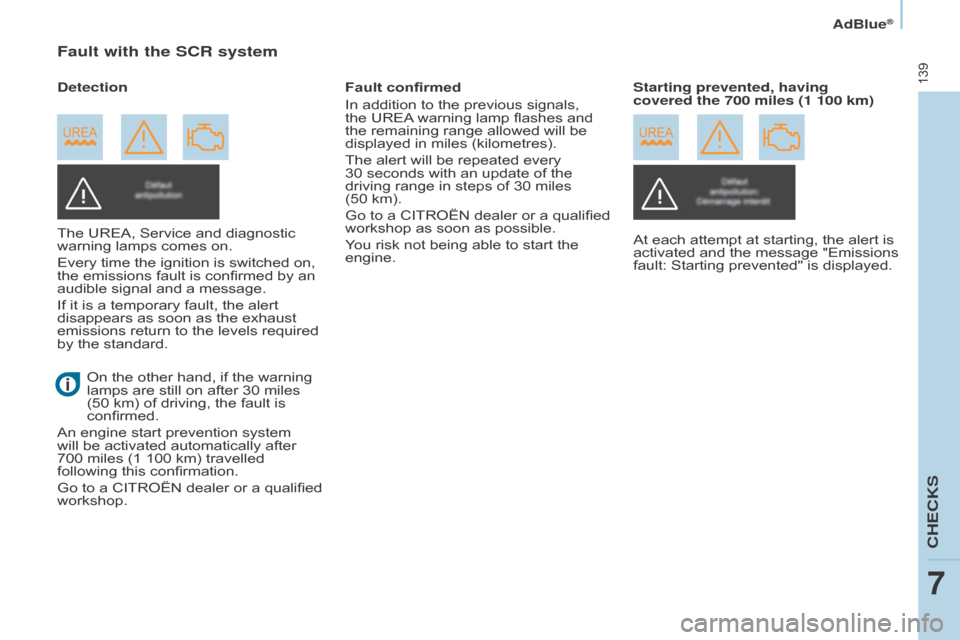
139
Berlingo2VU_en_Chap07_Verification_ed02-2016Berlingo2VU_en_Chap07_Verification_ed02-2016
Fault with the SCR system
The UREA, Service and diagnostic
warning lamps comes on.
Every time the ignition is switched on,
the emissions fault is confirmed by an
audible signal and a message.
If it is a temporary fault, the alert
disappears as soon as the exhaust
emissions return to the levels required
by the standard.Fault confirmed
In addition to the previous signals,
the UREA warning lamp flashes and
the remaining range allowed will be
displayed in miles (kilometres).
The alert will be repeated every
30 seconds with an update of the
driving range in steps of 30 miles
(50 km).
Go to a CITROËN dealer or a qualified
workshop as soon as possible.
You risk not being able to start the
engine.
Starting prevented, having
covered the 700 miles (1 100 km)
Detection
At each attempt at starting, the alert is
activated and the message "Emissions
fault: Starting prevented" is displayed.
On the other hand, if the warning
lamps are still on after 30 miles
(50 km) of driving, the fault is
confirmed.
An engine start prevention system
will be activated automatically after
700 miles (1 100 km) travelled
following this confirmation.
Go to a CITROËN dealer or a qualified
workshop.
CHECKS
7
AdBlue®
Page 142 of 260
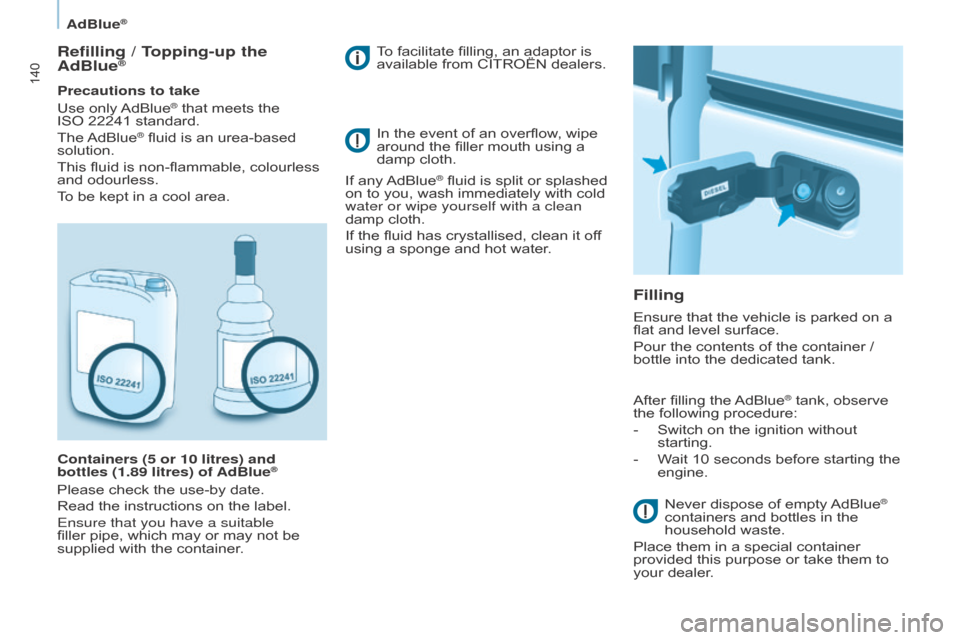
140
Berlingo2VU_en_Chap07_Verification_ed02-2016Berlingo2VU_en_Chap07_Verification_ed02-2016
Refilling / Topping-up the
AdBlue®
Precautions to take
Use only AdBlue® that meets the
ISO
22241 standard.
The AdBlue
® fluid is an urea-based
solution.
This fluid is non-flammable, colourless
and odourless.
To be kept in a cool area.
Containers (5 or 10 litres) and
bottles (1.89 litres) of AdBlue
®
Please check the use-by date.
Read the instructions on the label.
Ensure that you have a suitable
filler pipe, which may or may not be
supplied with the container.
Filling
In the event of an overflow, wipe
around the filler mouth using a
damp cloth.
If any AdBlue
® fluid is split or splashed
on to you, wash immediately with cold
water or wipe yourself with a clean
damp cloth.
If the fluid has crystallised, clean it off
using a sponge and hot water.
Ensure that the vehicle is parked on a
flat and level surface.
Pour the contents of the container /
bottle into the dedicated tank.
After filling the AdBlue
® tank, observe
the following procedure:
-
Switch on the ignition without
starting.
-
W
ait 10 seconds before starting the
engine.
Never dispose of empty AdBlue
®
containers and bottles in the
household waste.
Place them in a special container
provided this purpose or take them to
your dealer.
To facilitate filling, an adaptor is
available from CITROËN dealers.
AdBlue®
Page 143 of 260
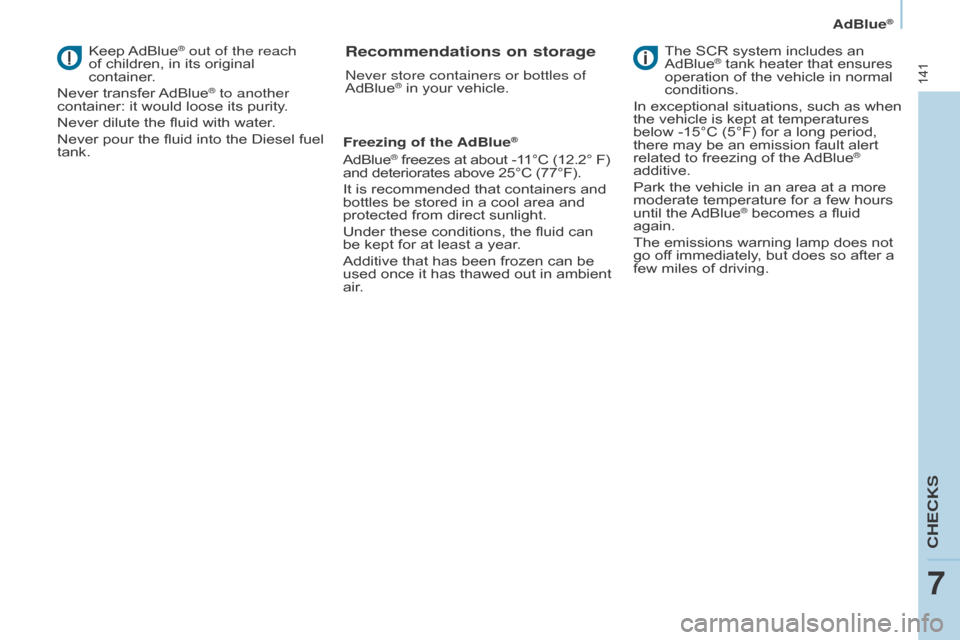
141
Berlingo2VU_en_Chap07_Verification_ed02-2016Berlingo2VU_en_Chap07_Verification_ed02-2016
Keep AdBlue® out of the reach
of children, in its original
container.
Never transfer AdBlue
® to another
container: it would loose its purity.
Never dilute the fluid with water.
Never pour the fluid into the Diesel fuel
tank.
Recommendations on storage
Never store containers or bottles of
AdBlue® in your vehicle.
Freezing of the AdBlue
®
AdBlue® freezes at about -11°C (12.2° F)
and deteriorates above 25°C (77°F).
It is recommended that containers and
bottles be stored in a cool area and
protected from direct sunlight.
Under these conditions, the fluid can
be kept for at least a year
.
Additive that has been frozen can be
used once it has thawed out in ambient
air. The SCR system includes an
AdBlue
® tank heater that ensures
operation of the vehicle in normal
conditions.
In exceptional situations, such as when
the vehicle is kept at temperatures
below -15°C (5°F) for a long period,
there may be an emission fault alert
related to freezing of the AdBlue
®
additive.
Park the vehicle in an area at a more
moderate temperature for a few hours
until the AdBlue
® becomes a fluid
again.
The emissions warning lamp does not
go off immediately, but does so after a
few miles of driving.
CHECKS
7
AdBlue®
Page 144 of 260

142
Berlingo2VU_en_Chap08_Aide-rapide_ed02-2016
BATTERY
Before disconnecting the battery, you
must wait for 2 minutes after switching
off the ignition.
Never disconnect a terminal when the
engine is running.
Never charge a battery without first
disconnecting the terminals.
After every reconnection of the battery,
switch on the ignition and wait 1 minute
before starting to allow the electronic
systems to be initialised. If problems
remain after doing this, please contact
a CITROËN dealer or a qualified
workshop.
After changing bulbs, wait
approximately 3 minutes before
reconnecting the battery.
It is advisable to disconnect the
battery if the vehicle is not to be
used for a period of more than one
month.
To charge the battery using a
battery charger
- Disconnect the battery.
-
Follow the instructions for use
given by the battery charger
manufacturer
.
-
Reconnect starting with the
negative (-) terminal.
-
Check that the terminals and
connectors are clean. If they are
covered with sulphate (white or
greenish deposit), disconnect them
and clean them.
To start the vehicle from
another battery
- Connect the red cable to the
positive (+) terminals of the
two batteries.
-
Connect one end of the green
or black cable to the negative (-)
terminal of the slave battery
.
-
Connect the other end of the green
or black cable to an earth point on
the broken down vehicle as far as
possible from the battery
.
-
Operate the starter
, let the engine run.
-
W
ait for the engine to return to idle,
then disconnect the cables.
The presence of this label
indicates the use of a 12 V
lead-acid battery with special
technology and specification, for which
the involvement of a CITROËN dealer
or qualified workshop is required when
replacing or disconnecting the battery.
Failure to observe this
recommendation may cause premature
wear of the battery.
After refitting the battery, the Stop &
Start system will only be active after
several hours depending on the
climatic conditions and the state of
charge of the battery (up to about
8
hours).
The Stop & Start battery does not have
to be disconnected for charging.
Battery
Page 145 of 260

143
Berlingo2VU_en_Chap08_Aide-rapide_ed02-2016Berlingo2VU_en_Chap08_Aide-rapide_ed02-2016
ECONOMY MODE
After the engine has stopped, with
the key in the ignition position, certain
functions (windscreen wiper, electric
windows, courtesy lamps, audio
equipment, etc.) can only be used for a
cumulative duration of thirty minutes, to
prevent discharging of the battery.
Once the thirty minutes have elapsed,
the active functions are put on standby
and the battery warning lamp flashes
accompanied by a message in the
screen.
To resume the use of these functions
immediately, start the engine and let it
run for a few minutes.
The time available will then be double
the time for which the engine was left
running. However, this time will always
be between five and thirty minutes.
A flat battery will prevent the
engine from starting.
TEMPORARY PUNCTURE RE -
P
AIR KIT
The kit is located in one of the two
storage compartments located under
the front seats.
Vehicles supplied with a temporary
puncture repair kit do not have a spare
wheel or tooling (jack, wheelbrace, ...).
The temporary tyre repair kit consists
of a compressor and a bottle
(containing a sealant).
Using the kit
- Tick the deflated wheel on the speed limitation sticker then affix
the sticker to the vehicle's steering
wheel to remind you that a wheel is
in temporary use.
-
Clip the bottle
1 on the
compressor
2.
-
Connect the bottle
1 to the valve of
the tyre to be repaired.
-
T
ake care to unwind the
compressor pipe before connecting
it to the bottle.
-
Connect the power lead to one of
the vehicle's 12V sockets.
-
Switch on the compressor by
pressing button
A until the tyre
pressure reaches 2.0 bars. If this
pressure cannot be reached, the
tyre cannot be repaired.
-
Remove and store the compressor
.
-
Drive immediately
, for a few miles
(kilometres), at reduced speed, to
fill the puncture.
-
Adjust the pressure using the
compressor in accordance with the
recommendation
for the vehicle and
check that the leak is filled correctly
(no further loss of pressure).
-
Drive at reduced speed (50
mph
[80 km/h]). The tyre must be
examined and repaired by a
specialist as soon as possible.
QUICK HELP
8
Changing a wheel
Page 146 of 260
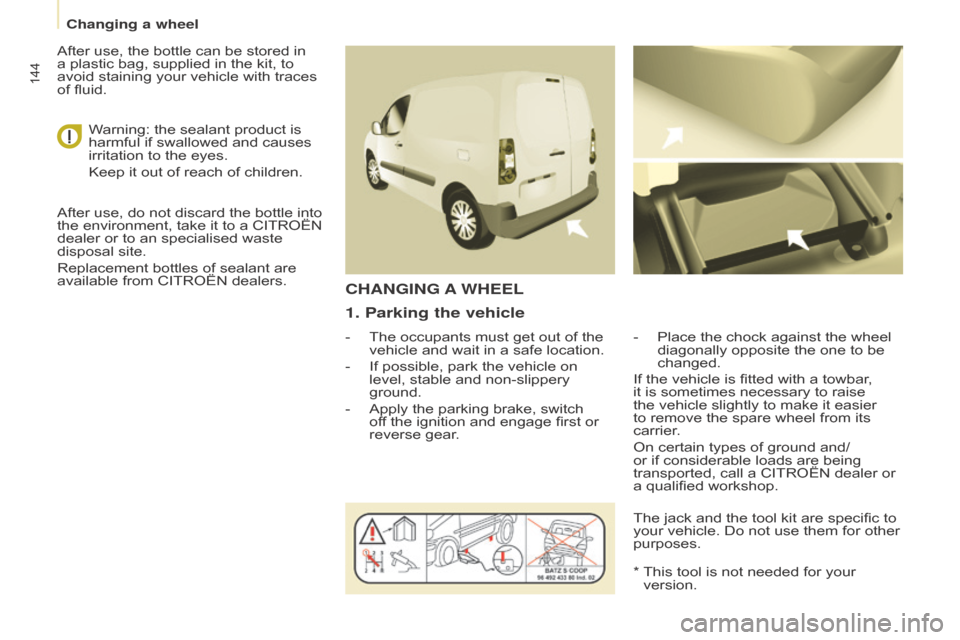
144
Berlingo2VU_en_Chap08_Aide-rapide_ed02-2016Berlingo2VU_en_Chap08_Aide-rapide_ed02-2016
1. Parking the vehicle
- The occupants must get out of the
vehicle and wait in a safe location.
-
If possible, park the vehicle on
level, stable and non-slippery
ground.
-
Apply the parking brake, switch
of
f the ignition and engage first or
reverse gear. -
Place the chock against the wheel
diagonally opposite the one to be
changed.
CHANGING A WHEEL
If the vehicle is fitted with a towbar,
it is sometimes necessary to raise
the vehicle slightly to make it easier
to remove the spare wheel from its
carrier.
On certain types of ground and/
or if considerable loads are being
transported, call a CITROËN dealer or
a qualified workshop.
*
This tool is not needed for your
version.
The jack and the tool kit are specific to
your vehicle. Do not use them for other
purposes.
W
arning: the sealant product is
harmful if swallowed and causes
irritation to the eyes.
Keep it out of reach of children.
After use, do not discard the bottle into
the environment, take it to a CITROËN
dealer or to an specialised waste
disposal site.
Replacement bottles of sealant are
available from CITROËN dealers. After use, the bottle can be stored in
a plastic bag, supplied in the kit, to
avoid staining your vehicle with traces
of fluid.
Changing a wheel
Page 147 of 260

145
Berlingo2VU_en_Chap08_Aide-rapide_ed02-2016Berlingo2VU_en_Chap08_Aide-rapide_ed02-2016
2. Tools
The tools are stowed in an open
storage compartment under a front
seat.
-
If necessary
, move the seat to
access the storage compartment
from the rear.
-
T
ake out the jack and tool carrier.
-
Remove the tools needed from the
carrier
.
1.
Jack.
2.
Wheelbrace.
3.
Chock.
4.
Rear lamp spanner
.
5.
Allow wheel trim removal tool*.
6.
T
owing eye.
3. Spare wheel
- Detach the carrier from the hook
and place the spare wheel near the
wheel to be changed.
-
Unscrew the bolt using the
wheelbrace until the carrier is
lowered fully
.
-
Open the rear doors to gain access
to the spare wheel.
QUICK HELP
8
Changing a wheel
Page 148 of 260
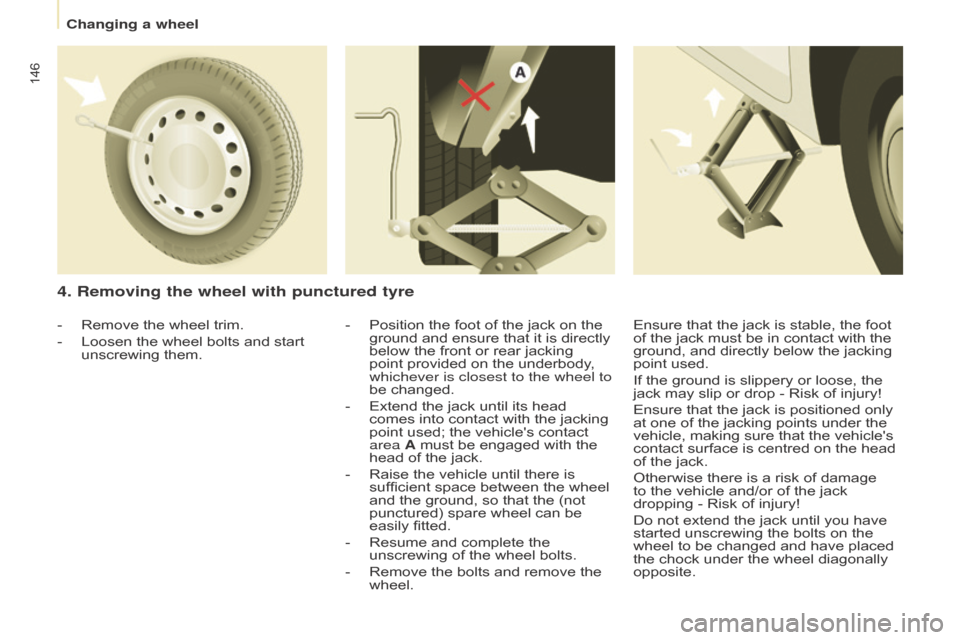
146
Berlingo2VU_en_Chap08_Aide-rapide_ed02-2016Berlingo2VU_en_Chap08_Aide-rapide_ed02-2016
4. Removing the wheel with punctured tyre
- Position the foot of the jack on the
ground and ensure that it is directly
below the front or rear jacking
point provided on the underbody,
whichever is closest to the wheel to
be changed.
-
Extend the jack until its head
comes into contact with the jacking
point used; the vehicle's contact
area
A must be engaged with the
head of the jack.
-
Raise the vehicle until there is
sufficient space between the wheel
and the ground, so that the (not
punctured) spare wheel can be
easily fitted.
-
Resume and complete the
unscrewing of the wheel bolts.
-
Remove the bolts and remove the
wheel.
-
Remove the wheel trim.
-
Loosen the wheel bolts and start
unscrewing them. Ensure that the jack is stable, the foot
of the jack must be in contact with the
ground, and directly below the jacking
point used.
If the ground is slippery or loose, the
jack may slip or drop - Risk of injury!
Ensure that the jack is positioned only
at one of the jacking points under the
vehicle, making sure that the vehicle's
contact surface is centred on the head
of the jack.
Otherwise there is a risk of damage
to
the vehicle and/or of the jack
dropping - Risk of injury!
Do not extend the jack until you have
started unscrewing the bolts on the
wheel to be changed and have placed
the chock under the wheel diagonally
opposite.
Changing a wheel
Page 149 of 260

147
Berlingo2VU_en_Chap08_Aide-rapide_ed02-2016Berlingo2VU_en_Chap08_Aide-rapide_ed02-2016
5. Fitting the spare wheel
- Position the wheel on the hub and
start tightening the bolts by hand.
-
Carry out an initial tightening of the
bolts using the wheelbrace. -
Lower the vehicle completely
by
folding the jack, then remove
the jack.
-
T
ighten the bolts again using the
wheelbrace, tighten them fully
without forcing them.
-
Place the wheel to be repaired in
the carrier
.
The spare wheel is not designed
to be used over long distances.
Have the tightening of the bolts
and the tyre pressure checked by
a CITROËN dealer or a qualified
workshop as soon as possible.
Have the original wheel repaired
and refitted by a CITROËN dealer
or a qualified workshop as soon as
possible. -
Secure the carrier on the hook then
raise the carrier by tightening the
bolt with the wheelbrace.
-
Fully tighten the bolt, then check
that the wheel is held flat against
the floor
.
If this is not the case, repeat the
operation.
Never go underneath a vehicle
that is supported only by a jack
(use a stand).
Never use a power driver in place of
the wheelbrace.
QUICK HELP
8
Changing a wheel
Page 150 of 260
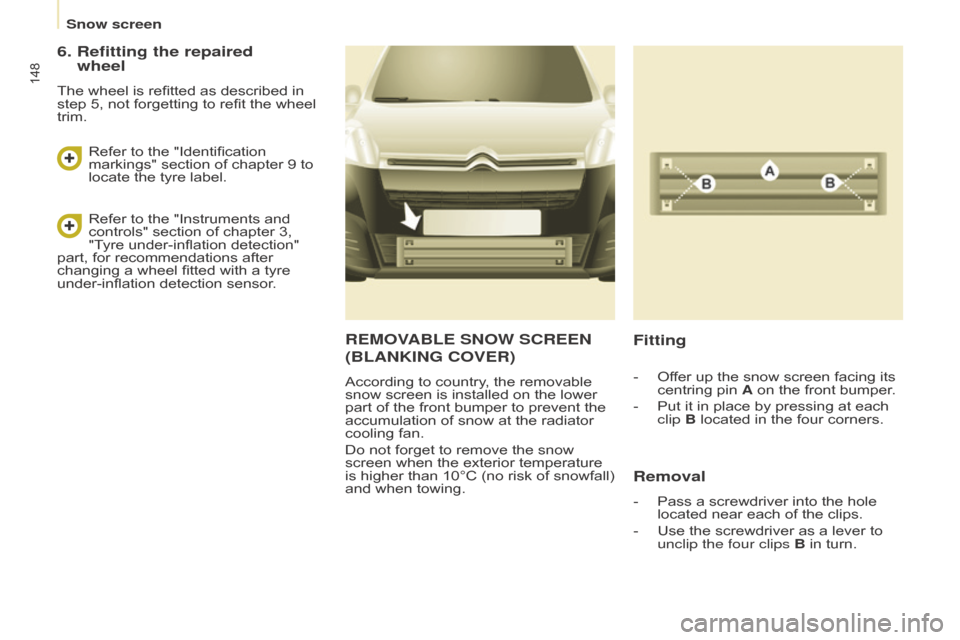
148
Berlingo2VU_en_Chap08_Aide-rapide_ed02-2016Berlingo2VU_en_Chap08_Aide-rapide_ed02-2016
REMOVABLE SNOW SCREEN
(
BLANKING COVER )
According to country, the removable
snow screen is installed on the lower
part of the front bumper to prevent the
accumulation of snow at the radiator
cooling fan.
Do not forget to remove the snow
screen when the exterior temperature
is higher than 10°C (no risk of snowfall)
and when towing.
Fitting
Removal
- Pass a screwdriver into the hole
located near each of the clips.
-
Use the screwdriver as a lever to
unclip the four clips
B in turn.
-
Of
fer up the snow screen facing its
centring pin A on the front bumper.
-
Put it in place by pressing at each
clip
B located in the four corners.
6. Refitting the repaired
wheel
The wheel is refitted as described in
step 5, not forgetting to refit the wheel
trim.
Refer to the "Identification
markings" section of chapter 9 to
locate the tyre label.
Refer to the "Instruments and
controls" section of chapter 3,
"Tyre under-inflation detection"
part, for recommendations after
changing a wheel fitted with a tyre
under-inflation detection sensor.
Snow screen